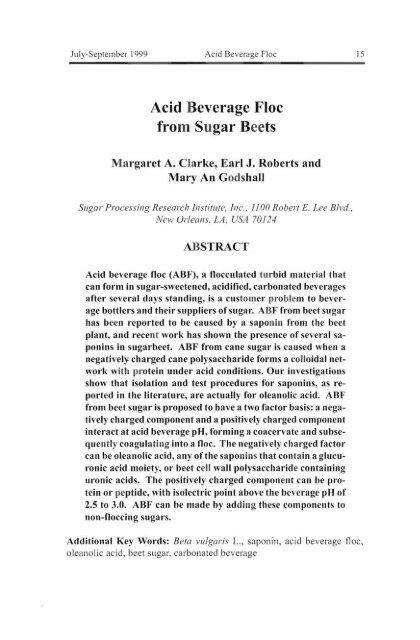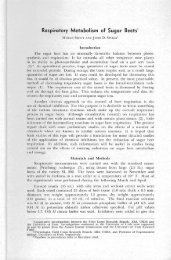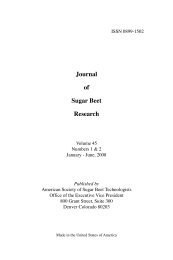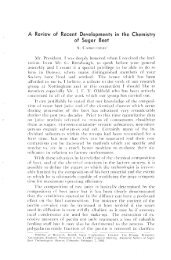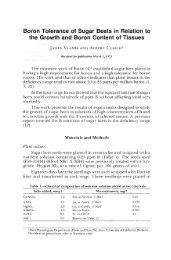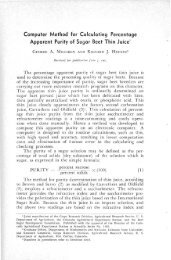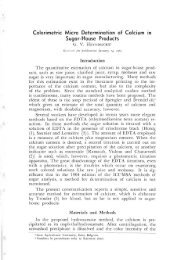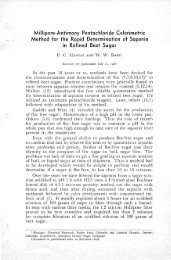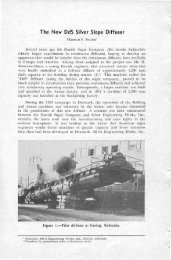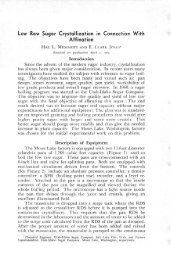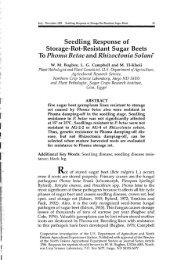Acid Beverage Floc from Sugar Beets - Vol
Acid Beverage Floc from Sugar Beets - Vol
Acid Beverage Floc from Sugar Beets - Vol
You also want an ePaper? Increase the reach of your titles
YUMPU automatically turns print PDFs into web optimized ePapers that Google loves.
July-September 1999 <strong>Acid</strong> <strong>Beverage</strong> <strong>Floc</strong><br />
<strong>Acid</strong> <strong>Beverage</strong> <strong>Floc</strong><br />
<strong>from</strong> <strong>Sugar</strong> <strong>Beets</strong><br />
Margaret A. Clarke, Earl J. Roberts and<br />
Mary An Godshall<br />
<strong>Sugar</strong> Processing Research In stitute, Inc., 1100 Robert E. Lee Blvd.,<br />
New Orleans, LA, USA 70124<br />
ABSTRACT<br />
<strong>Acid</strong> beverage floc (ABF), a flocculated turbid material that<br />
can form in sugar-sweetened, acidified, carbonated beverages<br />
after several days standing, is a customer problem to beverage<br />
bottlers and their suppliers ofsugar. ABF <strong>from</strong> beet sugar<br />
has been reported to be caused by a saponin <strong>from</strong> the beet<br />
plant, and recent work has shown the presence of several saponins<br />
in sugarbeet. ABF <strong>from</strong> cane sugar is caused when a<br />
negatively charged cane polysaccharide forms a colloidal network<br />
with protein under acid conditions. Our investigations<br />
show that isolation and test procedures for saponins, as reported<br />
in the literature, are actually for oleanolic acid. ABF<br />
<strong>from</strong> beet sugar is proposed to have a two factor basis: a negatively<br />
charged component and a positively charged component<br />
interact at acid beverage pH, forming a coacervate and subsequently<br />
coagulating into a floc. The negatively charged factor<br />
can be oleanolic acid, any ofthe saponins that contain a glucuronic<br />
acid moiety, or beet cell wall polysaccharide containing<br />
uronie acids. The positively charged component can be protein<br />
or peptide, with isolectric point above the beverage pH of<br />
2.5 to 3.0. ABF can be made by adding these components to<br />
non-floccing sugars.<br />
Additional Key Words: Beta vulgaris L., saponin, acid beverage floc,<br />
oleanolic acid, beet sligar, carbonated beverage<br />
15
16 Journal of <strong>Sugar</strong> Beet Research <strong>Vol</strong> 36, No 3<br />
<strong>Acid</strong> beverage floc (ABF), which can form in sugar-sweetened carbon<br />
ated soft drinks after several days standing, has been ascribed to both beet<br />
and cane sugars. In general, any haze or turbidity in a soft drink is referred<br />
to as "floc," but specific characteristics define acid beverage floc, most<br />
notably that shaking will make it disappear. Beet and cane flocs can appear<br />
as turbidity or as "cotton ball floc" Beet sugar floc is more granular in<br />
appearance and less fluffy than cane sugar floc. Beet sugar floc long has<br />
been ascribed to saponins (Eis et al. 1952; van der Poel et al. 1966; Carruthers<br />
et a!. 1967), but in our tests, authentic saponin added to non-floccing sugars<br />
in amounts approximating those reported in floccing sugar did not necessarily<br />
produce floc. The literature supports this: Eis (1952) says that<br />
"separated floc can produce effervescence and flocculation when sufficient<br />
neutral solution of the floc is added to carbonated beverages." By separated<br />
floc, the author meant all material that was precipitable at pH 2. In<br />
the authors' experience, "sufficIent" is far above the < 1 to 30 ppm levels of<br />
saponin reported in white sugars. Sufficient levels are above several hundred<br />
ppm. The objective of this study was the isolation of sugarbeet saponins<br />
for further study of their effect on acid beverage floc formation.<br />
The evidence for sugarbeet saponins being the cause of floc may be circumstantial.<br />
<strong>Acid</strong> beverage floc <strong>from</strong> cane sugars has two causative factors: a<br />
polysaccharide containing glucuronic acid and a protein, At least one specific<br />
regional acid beverage floc is caused by a specific microbial infection.<br />
In the general case, the polysaccharide is derived <strong>from</strong> plant cell wall<br />
material. The protein may be of cane origin or the residual <strong>from</strong> enzyme<br />
addition. The glucuronic acid and the primary amine residues are oppositely<br />
charged at beverage pH, and, through charge attraction, combine to<br />
form a coacervate as the basis for a floc network. Suspended solids, colloidal<br />
material, and high molecular weight soluble polymers such as dextran<br />
and starch can come out of solution and enhance the appearance of a<br />
floc that has already formed.<br />
Many tests for ABF are available, but none is good and all take several<br />
days to show results.<br />
Saponins<br />
Saponins are a class ofcompounds widely distributed in the plant kingdom<br />
in legumes, roots, shrubs and bushes, in varying degrees ofconcentration.<br />
Various saponins have been used as soaps because of their surface<br />
active properties. Saponin-containing plants, or their extracts, have been<br />
used in herbal medicine, in treatment ofvarious complaints including liver<br />
and cholesterol related diseases (Ireland et al. 1986), and as anti-fungal
18 Journal of <strong>Sugar</strong> Beet Research <strong>Vol</strong> 36, No 3<br />
Saponins are reported in sugarbeet at levels of 0.01 % to 0.2% of beet<br />
(Carruthers et a!. 1961; van der Poel et al. 1966; Hallanoro et al. 1990;<br />
Schiweck et a!. 1991), and at less than 100 ppm, generally less then 20<br />
ppm, in white sugar. Saponins are most densely concentrated just under<br />
the sugarbeet skin, where they function as plant defense compounds against<br />
disease and frost damage. They are also located in cell membranes<br />
(Hallanoro et a1. 1990). They are most highly concentrated in small beets<br />
grown in warm climates.<br />
In recent work comparing isolation systems and their products we suggested<br />
that material reported as "saponin" in sugars and process streams<br />
may in fact be oleanolic acid (Roberts et al. 1996). Oleanolic acid is derived<br />
<strong>from</strong> saponins by hydrolysis. The purpose of the work reported here<br />
was to determine whether oleanolic acid, derived <strong>from</strong> saponin by hydrolysis<br />
under processing conditions, is the actual flocculating agent in ABF, rather<br />
than saponin, as previously reported.<br />
MATERIALS AND METHODS<br />
Extraction of Saponins<br />
Beet peelings were obtained <strong>from</strong> fresh sugarbeet in the S.P.R.I. labs<br />
and subjected to several methods ofextraction. The resulting extracts were<br />
evaluated by thin layer chromatography and by GC-MS.<br />
1. lVlethod of Rother (1962): aqueous extraction. Fresh beet peelings<br />
weighing 5.5 kg were covered with water in a blender and divided into<br />
small pieces. The slurry was heated to 90EC and filtered on fabric. The<br />
residue was suspended in water, heated, and filtered again on fabric. The<br />
filtrate was adjusted to pH 1.5 with He 1, heated to 90EC for one hour, and<br />
allowed to settle overnight. After settling, the supernatant liquid was decanted.<br />
The residue was mixed with filter aid and filtered; the filtered<br />
residue was washed with water, adjusted to pH 1.5 with HCl, and allowed<br />
to air dry. The dried residue was extracted in a Soxhlet extractor with<br />
ethanol, the ethanol solution was concentrated and poured into water at pH<br />
1.5. The precipitate was dissolved in hot ethanol and again precipitated by<br />
pouring into pH 1.5 water. The precipitate was filtered off on hardened<br />
paper, dissolved in water, and evaporated to dryness at low temperature.<br />
The yield <strong>from</strong> the 5.5 kg offresh beet peeling was 3.0 g of brown material.<br />
Analysis of this material by TLC (as described below) showed oleanolic<br />
acid (the aglycone, or sapogenin) and nothing corresponding to saponins<br />
Mass spectroscopy analysis confirmed the presence of oleanolic acid.<br />
Apparently the harsh acidic treatment hydrolyzed the saponins, leaving only<br />
oleanolic acid in tile isolation.
july-September 1999 <strong>Acid</strong> <strong>Beverage</strong> <strong>Floc</strong><br />
2. Method of Ridout et al. (1994): aqueous extraction. In another experiment,<br />
1734 g of beet peel was ground in a blender. The slurry was<br />
filtered on fabric and the residue mashed with water. The pH of the filtrate<br />
was adjusted to 1.5 with HCI, heated to 85EC for 15 minutes, cooled overnight,<br />
and filtered on fabric coated with filter aid. The filtrate was returned<br />
to the filter twice more and the residue was washed with warm IN Hel.<br />
All filtrates were discarded. The filter was then washed with warm 2N<br />
NaOH solution until the filtrate was clear. The filtrate was placed in a large<br />
beaker and HCI was added to reduce the pH to 1.5. The precipitate was<br />
collected on fabric coated with filter aid as before, washed with IN HCI,<br />
and the filtrate discarded. The filter was then washed with warm 2N NaOH.<br />
The filtrate was acidified to pH 1.5 with HCl, filtered through Whatman<br />
542 paper, washed with water, and extracted with 500 ml of warm ethanol.<br />
The filtrate was evaporated to dryness, then taken up in water and freeze<br />
dried, yielding 2.0 g of brown material. TLC analysis showed oleanolic<br />
acid but no saponin.<br />
3. Method of Ridout et at (1994): methanol extraction. Freeze dried<br />
beet peel (650 g) was crumbled into small pieces and extracted in a Soxhlet<br />
extractor with methanol. The methanol was evaporated under reduced pressure;<br />
the residue was dissolved in water and extracted several times with 1butanol.<br />
The butanol was evaporated and the residue was dissolved in<br />
water and dialyzed against flowing tap water in a 12,000 MW cut-off bag<br />
for 24 hours. The material remaining in the bag was filtered, concentrated,<br />
and freeze dried, yielding 5.6 g of cream colored material. Thin-layer chromatography<br />
and mass spectrometry showed that the material contained saponins.<br />
Thin layer chromatography of isolates <strong>from</strong> aqueous extraction<br />
Isolates prepared by the traditional aqueous extraction methods (l and<br />
2), with repeated extractions at pH 1.5 and washing with base showed only<br />
oleanolic acid in the final dried extract and no saponins. Oleanolic acid<br />
identification on thin layer chromatography (solvent system: chloroform;<br />
methanol; water 65:35 : 10), made visible by 2N H2S04 or anisaldehyde spray,<br />
was confirmed by gas chromatography-mass spectrometry identification,<br />
as shown in Figures 2 through 4.<br />
Method I (Rother et al. 1962), aqueous extraction at low pH, yielded<br />
3g (0.05% on beet peel) brown solids; Method 2 (Ridout et al 1994), yielded<br />
2 g (0.12% on beet peel) of brown material. Method 3 (Ridout et al. 1994),<br />
similar to that oflreland (1986) using methanol extraction and not including<br />
low pH treatment, yielded 5.6 g (0.8% on beet peel) of cream colored<br />
material. Thin layer chromatography of the methanol extracted material<br />
showed five major components, two of which traveled with an authentic<br />
19
July-September 1999 <strong>Acid</strong> <strong>Beverage</strong> <strong>Floc</strong><br />
saponin (probably soybean) obtained <strong>from</strong> Sigma Chemical Co. It should<br />
be noted that "saponin extracts" supplied to S.P.R.I., Inc., by several sugar<br />
companies (sponsoring companies of S.P.R.I., Inc.) appeared to consist<br />
mainly of oleanolic acid.<br />
Gas chromatography-mass spectrometry (GC-MS)<br />
Samples containing oleanolic acid were converted to the trimethylsilyl<br />
(TMS) derivative by use ofPierce Tri-Sil" in pyridine solution. Gas chromatography<br />
(GC) was perfonned on a Hewlett Packard 5890. GC conditions<br />
were: 250EC for 10 min; increase temperature 5EC per min to 31 OEC<br />
for 10 min. The column was a 30 m x 0.25 mm fused silica with 0.25F<br />
film thickness of5% phenyl methyl silicone. Oleanolic acid eluted at 21.11<br />
minutes under these conditions. Mass spectrometry (MS) was conducted<br />
with a Hewlett Packard 5972 mass selective detector.<br />
Charged species at beverage pH<br />
Moving boundary electrophoresis on oleanolic acid was conducted in<br />
sucrose solution at pH 3, adjusted with phosphoric acid. Oleanolic acid<br />
moved towards the anode. The oleanol ic acid was thereby shown to have a<br />
negative charge at pH 3 in sucrose solution (simulating acid carbonated<br />
beverage conditions).<br />
RESULTS AND DISCUSSION<br />
Compositio'n and Structure of Beet Saponin Isolates<br />
Saponins are known to exist in variety in anyone plant - a single structure<br />
is not common. Variations in the sugar moiety structure and linkage<br />
position are observed. <strong>Sugar</strong>beet saponins are no exception. The three<br />
forms shown in Figure 1 all have oleanolic acid, a carboxylic acid triterpene,<br />
as their base unit.<br />
Comparison ofthe aqueous methods ofextraction with the methanolic<br />
method indicated that the sugarbeet saponins are indeed present in the peel.<br />
Chromatographic and mass spectroscopic data demonstrate that the saponins<br />
extracted by acidic aqueous methods have been hydrolyzed by the strong<br />
acid treatment so that only the aglycone (or sapogenin), oleanolic acid,<br />
remains. This observation throws some doubt on earlier work, all ofwhich<br />
isolated saponins by aqueous extraction with strong acid treatment. These<br />
earlier results may have been due to the presence ofoleanolic acid only and<br />
not to saponin, as ascribed. Earlier workers did not have the benefits of<br />
GC-MS but had to rely on colorimetric tests, which may give a false positive<br />
for saponins when oleanolic acid is present.<br />
23
24 Journal of <strong>Sugar</strong> Beet Research <strong>Vol</strong> 36, No 3<br />
In recent work, Ridout et a!. (1994) found saponins by aqueous extraction,<br />
not in extracts of beet roots, but only in extracts <strong>from</strong> beet molasses,<br />
where the compounds may be expected to concentrate. Subsequent investigations<br />
by the same workers (Massiot et al. 1994) found saponins in methanol<br />
extracts of sugarbeet roots and leaves.<br />
<strong>Beverage</strong> <strong>Floc</strong><br />
<strong>Floc</strong> tests (50 Brix, phosphoric acid to pH 2) were run on non-floccing<br />
sugars with the addition of various amounts of beet extract, or commercial<br />
saponin not <strong>from</strong> beet, or oleanolic acid. Saponin and oleanolic acid were<br />
also tested in combination with gelatin or a-amylase protein. The methanolic<br />
extract of beet root fonned a floc, as did the combination ofoleanolic acid<br />
and protein.<br />
The observation that saponins are apparently hydrolyzed during the<br />
acid extraction raises a basic question about causes of floc formation. The<br />
original assumption was that floc material was acid insoluble, and therefore<br />
the aqueous extraction method at low pH was developed. Saponins, if<br />
they pass through processing into the white sugar, might be hydrolyzed in<br />
carbonated beverages, where pH is about 2 to 2.5. In that case oleanolic<br />
acid and not saponin would be the immediate cause of floc formation.<br />
In our studies, only the material isolateu <strong>from</strong> sugarbeet by methanolic<br />
extraction was able to form floc when added to non-floccing sugar. This<br />
material contained whole saponin, indicating that saponin alone does form<br />
beverage floc. This methanolic extract contained many other compounds<br />
<strong>from</strong> beet in addition to saponins. The material isolated by acid extraction<br />
was able to form floc only when a protein was also added.<br />
The observations on hydrolysis explain why Eis (1952) observed flocculation<br />
only after adding back a relatively large quantity of isolated floc<br />
material. The amount added probably was sufficient to form a haze rather<br />
than a true floc .<br />
In past work (Roberts 1996; Clarke, 1992) we have observed that isolated<br />
beet sugar floc <strong>from</strong> beverages contained beet cell wall polysaccharide<br />
with galacturonic acid residues and protein. The polysaccharide, gIven<br />
the trivial name Indigenous Beet Polysaccharide (IBP), is comparable to<br />
the sugarcane cell wall polysaccharide, which contains glucuronic acid<br />
groups, and can cause acid beverage floc when in combination with a protein.<br />
At beverage pH the acid groups become negatively charged, the protein<br />
groups become positively charged, and charge attraction brings the<br />
molecules together to form a coacervate and then a flocculating network<br />
that entraps colloidal and suspended material to form a visible floc. We<br />
propose that a similar mechanism can be responsible for beet sugar floc. A<br />
carboxylic-acid containing molecule, such as saponin in a fonn that con
July-September 1999 <strong>Acid</strong> <strong>Beverage</strong> <strong>Floc</strong><br />
tains glucuronic acid, oleanolic acid, or cell wall polysaccharide, becomes<br />
negatively charged at low pH. A molecule containing an amino-group,<br />
such as protein, peptide, or other, becomes positively charged. The two<br />
come together <strong>from</strong> charge attraction to initiate a floc network. This explains<br />
the observation of floc without saponin present since another negatively<br />
charged molecule, possibly oleanolic acid, can participate. Both saponin<br />
and oleanolic acid contain a glucuronic acid group. Beet cell wall<br />
polysaccharides contain galacturonic acid groups. This mechanism accounts<br />
for the presence of saponin without floc, if insufficient protein or positively<br />
charged amino group is present. It also accounts for the presence of<br />
floc without saponin, if oleanolic acid or IBP is forming a coacervate with<br />
protein.<br />
<strong>Floc</strong> can be made in non-floccing beet or cane sugars by the addition<br />
of oleanolic acid and protein, as shown in Table I.<br />
Table 1. Determination of floc formation. Preparation: 240 g<br />
sugar, 500 ml water, 60 ml formaldehyde, pH 2-3, 10<br />
days. Ifadded: oleanolic acid, 5 mg; protein, 5 mg.<br />
<strong>Sugar</strong> Addition Results<br />
Beet, non-floccing<br />
Beet, non-floccing<br />
Beet, non-floccing<br />
Beet, non-floccing<br />
Beet, non-floccing<br />
Beet, floc positive<br />
Beet, floc positive<br />
Beet, floc positive<br />
Cane, non-floccing<br />
Cane, non-floccing<br />
Cane, non-floccing<br />
Cane, non-floccing<br />
Cane, non-floccing<br />
Cane, non-floccmg<br />
methanol extract<br />
oleanolic acid<br />
protein<br />
oleanolic acid + protein<br />
sapon 111<br />
oleanolic acid<br />
oleanolic acid + amylase<br />
oleanolic acid + gelatin<br />
oleanolic acid + beef serum<br />
oleanolic acid + dextranase<br />
oleanolic acid + invertase<br />
no floc<br />
floc<br />
floc<br />
no floc<br />
heavy floc<br />
fine floc<br />
fi ne floc<br />
heavy floc<br />
no floc<br />
fine floc<br />
coarse turbidity<br />
coarse turbidity<br />
fine noc<br />
fine floc<br />
25
26 Joumal of <strong>Sugar</strong> Beet Research <strong>Vol</strong> 36, No 3<br />
Saponin Tests<br />
All the postulates and observations in the literature depend on the validity<br />
of saponin tests The traditional tests must be re-evaluated using<br />
instrumental analysis to distinguish between saponin and oleanolic acid.<br />
Literature discussion on the most frequently lIsed test, the antimony<br />
pentachloride test, points out that its color reaction is not specific for<br />
triterpenes (van der Poel et a1. 1966). Therefore, the test cannot distinguish<br />
between saponin and oleanolic acid.<br />
CONCLUSIONS<br />
Comparison of traditional aqueous acid extracts of "saponin" <strong>from</strong><br />
sugarbeet substrates with methanol extraction has shown that aqueous extraction<br />
yields only the aglycone of beet saponins, oleanolic acid. Chromatographic<br />
and mass spectrometric evidence support this.<br />
A re-examination of the role of saponin in acid beverage floc and in<br />
foaming is recommended since oleanolic acid may be responsible for some<br />
of the problems ascribed to saponin.<br />
It is proposed that two factors are required to form floc, a molecule<br />
that is negatively charged at beverage pH, such as saponin, oleanolic acid,<br />
or cell wall polysaccharide, and a molecule that is positively charged at<br />
low pH, sllch as protein or peptide The two molecules combine in solution<br />
through charge attraction to form a coacervate that develops into a floc<br />
network.<br />
A quick test is needed to identify the presence of floc-causing factors<br />
in sugars used in acid carbonated beverages.<br />
ACKNOWLEDGEMENTS<br />
Grateful thanks are expressed to the sponsoring companies of <strong>Sugar</strong> Processing<br />
Research Institute, Inc. who supplied "saponin" extracts.<br />
LITERATURE CITED<br />
Carruthers, A., 1. F. T. Oldfield, 1. V. Dutton, L. C. Manning and M.<br />
Shore. 1961. Juice components in relation to sligar quality.<br />
British <strong>Sugar</strong> pic. Internal report.
July-September 1999 <strong>Acid</strong> <strong>Beverage</strong> <strong>Floc</strong><br />
Clarke, M. A., 1. M. de Bruijn, E. 1. Roberts, M. A. Goushall, R. S.<br />
Blanco and X. M. Miranda. 1992. Polysaccharides of beet and<br />
cane sugar: A progress report. Proc. Conf. <strong>Sugar</strong> Processing<br />
Res., pp. 353-37l.<br />
Eis, F. G., L. W. Clark, R. A. McGinnis and P. W. Alston. 1952. <strong>Floc</strong> in<br />
carbonated beverages. Ind. and Eng. Chem.: 2844-2848.<br />
Hallanoro, H., J. Ahvenainen and L. Ramm-Schmidt. 1990. Saponin, a<br />
cause of foaming problems in beet sugar production and use.<br />
Proc. Conf. <strong>Sugar</strong> Processing Res., pp. 174-203.<br />
Ireland, P. A., S. Z. Dziedzic and M. W. Kearsley. 1986. Saponin<br />
content of soya and some commercial soya products by means of<br />
high performance liquid chromatography of the sapogenins. 1.<br />
Sci. Food Agric. 37: 694-698.<br />
Massiot, G., M. G. Dijoux, C. Levaud, L. LeMen-Olivier, 1. D. Connolly<br />
and D. M. Sheeley. 1994. Seco-glycosides of oleanolic acid<br />
<strong>from</strong> Beta vulgaris. Phytochem. 37: 1667-1670.<br />
Ridout, C. L. , K. R. Price, G. Parkin, M. G. Dijoux and C. Lavaud.<br />
i 994. Saponins <strong>from</strong> sugarbeet and the floc problem. 1. Agric.<br />
Food Chem. 42: 273-282.<br />
Roberts, E. J., M. A. Clarke, M. A. Godshall and L. A. Edye. 1996.<br />
Saponins <strong>from</strong> sugarbeet. Proc. Conf. <strong>Sugar</strong> Processing Res.,<br />
pp. 492-500.<br />
Roberts, E. 1. and M. A. Clarke. 1991 . Internal Reports, <strong>Sugar</strong> ProcesslIlg<br />
Research Institute, Inc.<br />
Rother, H. 1962. Saponin precipitations in sugar sweetened, clear soft<br />
drinks. Zucker: 196-199.<br />
Schiweck, H., G. Steinle and E. Fischer. 1991. Detennination of<br />
sapogenins in sligar factory products and processes. Proc.<br />
c.1.T.S., pp. 441-455.<br />
Van der Poel, P. W., M. L. A. Verhaart and N. H . M. de Visser. 1966.<br />
The course of the non-sugars <strong>from</strong> thick juice to white sugar.<br />
International <strong>Sugar</strong> 1. 66: 317-319, 349-352.<br />
27


